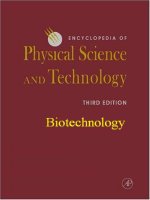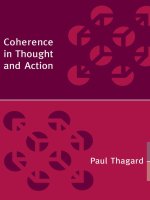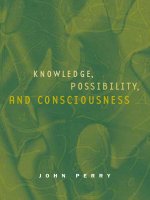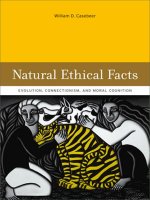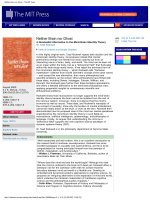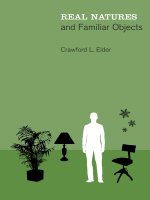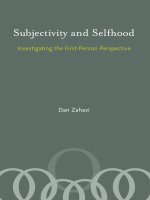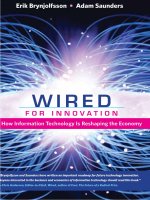the mit press information arts intersections of art science and technology nov 2001
Bạn đang xem bản rút gọn của tài liệu. Xem và tải ngay bản đầy đủ của tài liệu tại đây (15.72 MB, 968 trang )
TEAMFLY
Team-Fly
®
Information Arts
leonardo
Roger F. Malina, series editor
Designing Information Technology, Richard Coyne, 1995
Technoromanticism: Digital Narrative, Holism, and the Romance of the Real, Richard Coyne, 1999
The Visual Mind, edited by Michele Emmer, 1994
The Robot in the Garden: Telerobotics and Telepistemology in the Age of the Internet, edited by Ken
Goldberg, 2000
Leonardo Almanac, edited by Craig Harris, 1994
In Search of Innovation: The Xerox PARC Artist-in-Residence Program Project, edited by Craig
Harris, 1999
The Digital Dialectic: New Essays on New Media, edited by Peter Lunenfeld, 1999
Immersed in Technology: Art and Virtual Environments, edited by Mary Anne Moser with Douglas
MacLeod, 1996
Information Arts: Intersections of Art, Science, and Technology, Stephen Wilson, 2002
Information Arts
Intersections of Art, Science, and Technology
Stephen Wilson
The MIT Press
Cambridge, Massachusetts
London, England
2002 Stephen Wilson
All rights reserved. No part of this book may be reproduced in any form by any electronic or
mechanical means (including photocopying, recording, or information storage and retrieval) with-
out permission in writing from the publisher.
This book was set in Bell Gothic and Garamond by Achorn Graphic Services, Inc., and printed
and bound in the United States of America.
Library of Congress Cataloging-in-Publication Data
Wilson, Stephen, 1944–
Information arts: intersections of art, science, and technology / Stephen Wilson.
p. cm.—(Leonardo)
ISBN 0-262-23209-X (hc: acid-free paper)
1. Art and science. 2. Art and technology. I. Title. II. Leonardo (Series) (Cambridge, Mass.).
N72.S3 W55 2002
701′.05—dc21
00-038027
Contents
selected artists xiii
selected technologies xvii
series foreword xix
foreword by joel slayton xxi
preface xxiii
1 Introduction, Methodology, Definitions, and Theoretical Overview 1
1.1 art and science as cultural acts 2
A Quiz 4
Revisiting the Relationship of Art and Techno-Scientific Research 5
Organization of the Book 7
The Deficiency of Categorization 8
What Areas of Technological Art Are Included? Which Are Not? 9
Definitions and Theoretical Reflections 11
Similarities and Differences between Science and Art 18
Critical Theory and Problematic Issues in the Integration of Art and
Techno-Scientific Research
20
Artists’ Stances in Integrating Research 25
Summary: The End of Timelessness? 30
1.2 elaboration on the approach of art as research 34
Can the Arts Offer Alternatives in Setting Research Agendas, Interpreting
Results, and Communicating Findings?
35
What Is a Viable Role for Artists in Research Settings? What Can Researchers
Contribute to Art and What Can Artists Contribute to Research? What Can
High-Tech Companies Gain from Artists Being Involved?
36
Art Characteristics Useful for Research 38
Preparing Artists for Research 39
The Integration of Research and Art 40
Art and Science/Technology Collaborations 41
Future Possibilities 48
2 Biology: Microbiology, Animals and Plants, Ecology, and Medicine and
the Body 53
2.1 biology: research agendas and theoretical overview 54
Introduction 55
Research Agendas in Biology and Medicine 56
Areas of Cultural Significance in Biological Research 59
Theoretical Perspectives on Biology and the Body 72
Rethinking the Body and Medicine 77
Searching for Aesthetic Form in Art and Science 84
How Are Biology-Based Theory and Research Important to the Arts? 88
2.2 artists working with microbiology 94
Introduction: Microbiology and Genetics as Artistic Interest 95
Manipulations and Investigations of the Microworld 96
Creating Forms and Visualizations Based on Its Structures, Including the New
Iconography of Gene Mapping
101
Reflections on the Processes of Genetic Science and Its Social Implications 105
Summary: Micro Steps 108
2.3 plants and animals 110
Introduction 111
Invertebrates 112
Arthropods: Insects and Spiders 116
Plants 118
Vertebrates 120
Acoustic Ecology 123
Summary 126
2.4 ecological art 128
Ecology: Organic Life as a System 129
Questions Raised by Artistic Interest in Ecology 130
Historical Examples of Artistic Work 131
Contemporary Artistic Work with Ecological Concepts 133
Summary: Linking Science and Art in Action 146
2.5 body and medicine 148
Introduction: Bodies, Technology, and Theory 149
Extropian and Post-Human Approaches 154
Contents
vi
Artists’ Experiments with Technological Stimulation 157
Artists’ Experiments with Smell 169
Artists’ Experiments with Surgery 170
Experiments with Tissue Culture 174
Body Modification 174
Brain Processes, Heartbeats, Breath, Biosensors, and Psychology 180
The Psychological Processes of Perception, Cognition, Appreciation, and Creativity 189
Body Imaging 189
Medicine, Hospitals, Bodily Fluids, and Death 193
Summary: Dissecting the Body 198
3 Physics, Nonlinear Systems, Nanotechnology, Materials Science,
Geology, Astronomy, Space Science, Global Positioning System, and
Cosmology 201
3.1 physical science research agendas and theoretical reflections 202
Introduction: Questions about the Biggest and Smallest of Things 203
Survey of Research Fields and Agendas 204
Nonlinear Systems, Chaos, and Complexity 207
Astronomy, Cosmology, and Space Science 209
Epistemology—How Do We Know What We Know? 211
Potentially Important Emergent Technologies 213
Summary: Artist Explorations of Physical Science Research and Concepts 221
3.2 atomic physics, nanotechnology, and nuclear science 222
Atomic Physics 223
Viewing and Manipulating the Atomic World—Nanotechnology 226
Nuclear Science 230
Summary: Difficulties of Working at the Atomic Level 233
3.3 materials and natural phenomena: nonlinear dynamic systems,
water, weather, solar energy, geology, and mechanical
motion
234
Nonlinear Systems 235
Natural Phenomena—Oceans, Water, and Moving Liquid 239
Natural Phenomena—Erosion and Geological Action 241
Natural Phenomena—The Sky, Winds, and Weather 244
Solar Art 246
Mechanics—Oscillation and Pendulum Action 251
Fire, Heat, Magnetics, and Electromagnetics 253
Materials Science, Rapid Prototyping, and Chemistry 253
Summary: Pattern Finding and Poetry of Matter 256
Contents
vii
3.4 space 260
Artistic Interest in Space 261
Views from Space 263
Art Viewed from Earth 265
Art Executed in Space and Weightlessness 268
Painting and Photography Based on Space Exploration 271
Conceptual and Electronic Works 271
Search for Extra Terrestrial Intelligence (SETI) 275
Art Critiques of Space Research 278
Summary: The Hopes 279
3.5 global positioning system (gps) 282
Possibilities and Dangers 283
Artistic Experimentation with GPS 283
Summary: Unexpected Implications 292
4 Algorithms, Mathematics, Fractals, Genetic Art, and Artificial Life 295
4.1 research agendas in mathematics and artificial life 296
Why Is Mathematics Part of a Book on Science, Technology, and Art? 297
A Review of Research Agendas in Mathematics 298
Artificial Life 302
Theoretical Perspectives on A-Life 305
Summary 311
4.2 algorithmic art, art and mathematics, and fractals 312
Algorithmic Art 313
Art and Mathematics 320
Fractals 330
Promise and Problems in Art and Mathematics and Algorithmic Art 333
Literacy—Audience Background 334
Understanding Systems 336
Abstraction and Cultural Theory 337
4.3 artificial life and genetic art 340
A-Life Sculpture and Autonomous Agents 341
Genetic, Evolutionary, and Organic Art 351
5 Kinetics, Sound Installations, and Robots 367
5.1 robotics and kinetics 368
Introduction: Robots—Creatures of Art and Science 369
An Overview of Scientific and Technological Research Agendas 371
Contents
viii
Examples of Conceptual Challenges and Approaches 374
Robots and Popular Culture 382
Summary: Robot Hopes, Fears, and Realities 383
5.2 conceptual kinetics and electronics 386
Artistic Research 387
Kinetic Art Precursors 388
Kinetics and Light Sculpture 389
Conceptual Kinetics 392
Summary: More Than Robotics 405
5.3 kinetic instruments, sound sculpture, and industrial music 406
A Brief Theoretical Overture 407
Experiments in Sound Installation 409
Summary: Research as Art 422
5.4 robots 424
Robotic Theater and Robotic Dance 425
Autonomy 427
Extreme Performance, Destruction, Mayhem, and Control 432
Social Metaphors 440
Extending Robot Motion and Interfaces 446
Robot Architecture 451
Summary: Kinetics and Robots—Hybrids of Art and Science 454
6 Telecommunications 457
6.1 telecommunications research agendas and theoretical
reflections
458
Introduction: Overcoming Distance 459
Telecommunications Research and Development 460
Research Trends in Telepresence 469
The Meaning of the Telecommunications ‘‘Revolution’’ 473
The Exploration of New Possibilities 481
Summary: Telecommunications—The Grand Cyber Debate 484
6.2 telephone, radio, and net.radio 486
A Brief History of Telematic Art 487
Theoretical Perspectives on Telephone Art 488
Examples of Telephone-Based Art 490
Radio, Television, and Wireless 497
Radio-Based Art and Theater Installations 503
Art Radio 504
Contents
ix
The Migration to Net.Radio 507
Summary: Dangers and Opportunities in Convergence 511
6.3 teleconferencing, videoconferencing, satellites, the internet, and
telepresence
514
Teleconferencing, Videoconferencing, Satellites, and Internet Collaboration 515
Telepresence Definitions 526
Artists Exploring Telepresence 528
Visualizing Net Activity 549
Parapsychological Communication 554
Summary: Being There 556
6.4 web art 558
Critical Perspectives on Web Art 561
Archive and Information Sites 564
Projects to Accumulate Web-Viewer Opinions 572
Genetic Art Using Web-Visitor Voting 573
Recomposing Web Resources 576
Collaborative Environments and Person-to-Person Communication 579
The Development of New Capabilities 585
Reflections about the Net 589
Arrangements That Use Readings of the Physical World to Affect the Web 596
Cool Sites 599
Summary: The Web as an Art Arena 600
7 Digital Information Systems/Computers 603
7.1 research agendas and theoretical overview 604
Introduction: The Computer Revolution 605
Diverse Histories of Technological Imagination 605
Research Agendas 607
Theoretical Reflections on the Digital Culture and Art 630
Summary: Debate in the Art Community—Possibilities of an Enhanced Future 657
7.2 computer media 664
Introduction: Extensions of Photography, Cinema, Video, and Literature 665
Deconstructive and Feminist Critiques of Cultural Trends 666
Extending Poetic and Expressive Capabilities 671
Art Games 676
Multi-Person Events 679
Video Installation 680
Contents
x
TEAMFLY
Team-Fly
®
Interactive Documentary 685
Hyperfiction 688
Summary: Computer Media—The Next Stages of Cinema and Television? 689
7.3 virtual reality 692
Introduction: Artists as Architects of Virtual Reality 693
Unorthodox Spaces and Characters 694
The Virtual Reality World as Metaphor 705
Alternative Objects and Creatures 709
Relationships between the Physical and the Virtual 712
Information Visualization 717
Distributed Virtual Reality 721
Virtual Reality, Music, and Theater 722
Research and Commercial Virtual Reality Environments 725
Summary 726
7.4 motion, gesture, touch, gaze, manipulation, and activated
objects
728
Introduction: Reworking the Interface 729
Motion 730
Gesture 745
Touch and Tactility 749
Gaze 755
Face Recognition 758
Complex Actions—Balance, Walking, and Bicycling 760
Breath 764
Activated Objects 764
Summary: Can a Computer Do More Than See and Hear? 772
7.5 speech synthesis, voice recognition, and 3-d sound 774
Sound Research 775
3-D Sound 776
Speech Synthesis and Manipulation 780
Speech Recognition 782
Summary: Something to Talk About 784
7.6 artificial intelligence 786
Artificial Intelligence Research 787
Algorithms for Creativity 789
Image and Speech Recognition 794
Interactions with Artificial Characters 797
Contents
xi
Affective Computing 804
Agents 806
Summary: The Role of the Arts in Artificial Intelligence and Agent Research 809
7.7 information and surveillance 812
Information Management, Visualization, Commerce, and Surveillance 813
Bar Codes and ID Technologies 814
Surveillance 815
Databases and Research Processes 822
Information Visualization 829
Reflections on Science 833
Information Organizations and Structures 836
Summary: Being Formed by Information 846
8 Resources 849
8.1 exhibitions and festivals; educational programs; art, and research
collaborations; organizational resources, think tanks, and web
resources
850
Permanent Spaces, Museums, and Comprehensive Institutions 851
Competitions and Festivals 857
Organizations and Information Publishers 860
Art and Science-Technology Sponsors, Competitions, and Academic Convergence
Programs
865
Think Tanks and University Labs 866
Educational Resources 868
Research Conferences, Science Magazines, Trade Magazines, and Science and
Technology Studies
872
Summary: Institutions as Art 873
8.2 summary—the future 874
Appendixes 879
A methodology 880
B books for further inquiry 886
name index 905
subject index 923
Contents
xii
Selected Artists
Artists include:
James Acord
Kristi Allik
Mark Amerika
Suzanne Anker
Marcel.li Antunez Roca
Margo K. Apostolos
Roy Ascott
Franko B
Nicolas Anatol Baginsky
Harlyn Baker
Bill Barminski
Gregory Barsamian
Louis Bec
Konrad Becker
Tony Belaver
Guy Ben-Ary
Maurice Benayoun
Bob Bingham
Trevor Blackwell
Marc Bo
¨
hlen
Christian A. Bohn
Karl Bohringer
Tom Bonauro
Johnny Bradley
Benjamin Britton
Shawn Brixey
Peter Broadwell
Sheldon Brown
Leif Brush
C5
Patrice Caire
Jim Campbell
Bruce Cannon
Oron Catts
Shu Lea Cheang
Mel Chin
Richard Clar
Mary Anne Clark
Harold Cohen
Brent Collins
Tim Collins
Pierre Comte
Luc Courchesne
Donna Cox
Jordan Crandall
Trevor Darrell
Char Davies
Joe Davis
List of Artists
xiv
Walter De Maria
Paul DeMarinis
Louis-Philippe Demers
Andrea Di Castro
Stewart Dickson
Elizabeth Diller
Mark Dion
Diana Domingues
Abbe Don
Kitsou Dubois
John Dunn
Hubert Duprat
Christopher Ebener
Stephan Eichhorn
Arthur Elsenaar
Brian Evans
Ken Feingold
Gregory Fischer
Monika Fleischmann
Bill Fontana
Felice Frankel
Masaki Fujihata
Rebecca Fuson
Ulrike Gabriel
Kit Galloway
Paul Garrin
George Gessert
Bruce Gilchrist
JoAnn Gillerman
Ken Goldberg
Guillermo Go
´
mez-Pen
˜
a
George Gonzalez
Gaile Gordon
Reiko Goto
Sharon Grace
Group Spirale
Kazuhiko Hachiya
Newton Harrison
Helen Harrison
Emily Hartzell
Steven Hartzog
Grahame Harwood
Agnes Hegedu
¨
s
Michael Heivly
Nigel Helyer
Lynn Hershman
Paul Hertz
Jerry Hesketh
Perry Hoberman
Eric Hobijn
Carsten Ho
¨
ller
Bart Hopkins
Lisa Hutton
Tjark Ihmels
Toshio Iwai
Natalie Jeremijenko
Jodi.org
Ludwig John
Eduardo Kac
Ned Kahn
Paras Kaul
Yves Klein
Vitaly Komar
Milton Komisar
Richard Kriesche
Myron Krueger
Ted Krueger
Gregory Kuhn
Mierle Landerman Ukeles
Jaron Lanier
Eve Andre
´
e Larame
´
e
Brenda Laurel
Ray Lauzzanna
George Legrady
List of Artists
xv
Webster Lewin
Carl Loeffler
Rafael Lozano-Hemmer
Dirk Luesebrink
James Luna
Chico MacMurtie
John Maeda
Judy Malloy
Steve Mann
Wojciech Matusik
Delle Maxwell
Alex Melamid
Laurent Mignonneau
Seiko Mikami
MIT Media Lab Aesthetics and
Computation Group
Bonnie Mitchell
Christian Mo
¨
ller
Gordon Monahan
Knut Mork
Iain Mott
Robert Mulder
Antonio Muntadas
Fakir Musafar
Ken Musgrave
Rob Myers
Michael Naimark
Ikuo Nakamura
Eric Nyberg
Orlan
Karen O’Rourke
Ed Osborn
Randall Packer
Eric Paulos
Kate Pendry
Simon Penny
Jean-Marc Philippe
Clifford Pickover
Ian Pollock
Sherrie Rabinowitz
John Randolph
Sonya Rapoport
Alan Rath
Thomas Ray
Mark Reaney
Catherine Richards
Peter Richards
Ken Rinaldo
Don Ritter
Keith Roberson
Sara Roberts
Alexis Rockman
Bryan Rogers
Kathleen Rogers
David Rokeby
David Rosenboom
Teri Rueb
Eric Samakh
Joachim Sauter
Remko Scha
Stefan Schemat
Julia Scher
Thecla Schiphorst
Barry Schwartz
Ricardo Scofidio
Jill Scott
Bill Seaman
Seemen
Carlo Sequin
Paul Sermon
Jeffrey Shaw
Roberto Sifuentes
Todd Siler
Janet Silk
List of Artists
xvi
Karl Sims
Joel Slayton
David Small
Alexa Smith
Nina Sobell
Christa Sommerer
Alan Sonfist
Martin Spanjaard
Richard Stanford
Ed Stastny
Stelarc
Stahl Stenslie
Wolfgang Strauss
Rachel Strickland
Susan Stryker
Athena Tacha
Ed Tannenbaum
Project Taos
Nell Tenhaaf
Rob Terry
Mark Thompson
Mark Thorpe
Bruce Tombs
John Tonkin
Naoko Tosa
Michael Touma
Trimpin
Normal Tuck
Tom Van Sant
Paul Vanouse
Roman Verostko
Bill Vorn
Tamas Waliczky
Marius Watz
Peter Weibel
Barry Brian Werger
Norman White
Tom White
Neil Wiernik
Gail Wight
Stephen Wilson
Uli Winters
Andrea Wollensak
John Woodfill
Arthur Woods
Kirk Woolford
Kenji Yanobe
Pamela Z
Ionat Zurr
List of Technologies
xvii
Selected Technologies
Research areas include:
Bioengineering
Microbiology and genetics
Smell, taste, and touch sensors
Biosensors
Bioidentification and Biosurveillance
Neuroscience
Bionics
Parapsychology and bioelectricity
Biological warfare
Plant and animal behavior
Ecology
Technological stimulation of the body
Surgery
Tissue culture
Brain monitoring
Heartbeat and breath monitoring
Body modification
Perception and cognition
Body imaging
Death processes
Nonlinear systems, complexity, and chaos
Particle physics
Nanotechnology
Materials science
Rapid prototyping
Global positioning system (GPS)
Geology and seismic activity
Fluid dynamics
Meteorology
Solar energy
Fire and magnetics
Theoretical math
Fractals
Algorithms
Artificial Life
Genetic Algorithms
Robot vision and motion
Robot autonomy
Subsumption architecture
Humanoid robots
Living architecture
Wireless communication and mobile
computing
Location sensitive communication
Electromagnetic spectrum
List of Technologies
xviii
Desktop video
Computer Telephone Integration (CTI)
Virtual communities and telecollaboration
Telepresence
Remote museums
Telemedicine
Synthetic image and telecommunication
integration
Visualizing net activity
Autonomous flying vehicles
Parapsychological communication
Gesture and touch recognition
Speech recognition and synthesis
Face and facial expression recognition
Object tracking and identification
Video surveillance
Music recognition
Haptics
3-D sound
Motion simulation
Force feedback
Immersive virtual reality
Automatic video interpretation
Synthetic scene generation
Ambient sound and sound localization
Speaker identification and tracking
Earcons and sonification
Autonomous software agents
Social and emotional computing
Artificial intelligence
Information visualization and foraging
Augmented reality systems
Tangible bits
Ubiquitous/pervasive/invisible computing
Wearable computing
Smart spaces, houses, highways
Series Foreword
Editorial Board: Roger F. Malina, Denise Penrose, and Pam Grant Ryan
The cultural convergence of art, science, and technology provides ample opportunity
for artists to challenge the very notion of how art is produced and to call into question
its subject matter and its function in society. The mission of the Leonardo book series,
published by the MIT Press, is to publish texts by artists, scientists, researchers, and
scholars that present innovative discourse on the convergence of art, science, and tech-
nology.
Envisioned as a catalyst for enterprise, research, and creative and scholarly experimen-
tation, the book series enables diverse intellectual communities to explore common
grounds of expertise. The Leonardo book series provides a context for the discussion of
contemporary practice, ideas, and frameworks in this rapidly evolving arena where art
and science connect.
To find more information about Leonardo/ISAST and to order our publications, go
to Leonardo Online at 〈 />or send e-mail to 〈leonardobooks.mitpress.mit.edu〉.
Joel Slayton
Chairman, Leonardo Book Series
Book Series Advisory Committee: Annick Bureaud, Pamela Grant Ryan, Craig Harris,
Roger Malina, Margaret Morse, Michael Punt, Douglas Sery, Allen Strange.
Leonardo/International Society for the Arts, Sciences, and Technology (ISAST)
Leonardo, the International Society for the Arts, Sciences, and Technology, and the
affiliated French organization Association Leonardo have two very simple goals:
1. to document and make known the work of artists, researchers, and scholars interested
in the ways that the contemporary arts interact with science and technology, and
2. to create a forum and meeting places where artists, scientists, and engineers can
meet, exchange ideas, and, where appropriate, collaborate.
When the journal Leonardo was started some 35 years ago, these creative disciplines
existed in segregated institutional and social networks, a situation dramatized at that
time by the ‘‘Two Cultures’’ debates initiated by C. P. Snow. Today we live in a different
time of cross-disciplinary ferment, collaboration, and intellectual confrontation enabled
by new hybrid organizations, new funding sponsors, and the shared tools of computers
and the Internet. Above all, new generations of artist-researchers and researcher-artists
are now at work individually and in collaborative teams bridging the art, science, and
technology disciplines. Perhaps in our lifetime we will see the emergence of ‘‘new Leo-
nardos,’’ creative individuals or teams who will not only develop a meaningful art for
our times but also drive new agendas in science and stimulate technological innovation
that addresses today’s human needs.
For more information on the activities of the Leonardo organizations and networks,
please visit our Web site at 〈 />Roger F. Malina
Chairman, Leonardo/ISAST
ISAST Board of Directors: Barbara Lee Williams, Martin Anderson, Mark Resch, Mark
Beam, Sonya Rapoport, Stephen Wilson, Lynn Hershman Leeson, Joel Slayton, Penel-
ope Finnie, Curtis Karnow, Mina Bissell, Rich Gold, Beverly Reiser, Piero Scaruffi.
Series Foreword
xx
TEAMFLY
Team-Fly
®
Foreword
Stephen Wilson’s Information Arts: Intersectio ns of Art, Science, and Technology is the first
comprehensive international survey of artists working at the frontiers of scientific inquiry
and emerging technologies. The scope of Information Arts is encyclopedic: it is both a
critical text and practical resource guide. The expansive taxonomy of art and research is
accentuated by theoretical perspectives, analysis, and art commentaries that address a di-
verse range of ideological positions. Information Arts also provides resources on organiza-
tions, publications, conferences, museums, educational programs, and research centers.
Steve Wilson provides a mirror that captures the essence and agendas represented by
contemporary efforts of artists to integrate scientific research into their work and enter-
prise. Offering a critical context of their agendas, he examines research that crosses the
intellectual terrain of biology, physics, materials science, astronomy, cognitive science,
engineering, medicine, architecture, and social and information science. This research
indicates that although art and science share many characteristics, a special role for the
arts exists in the evolution and deployment of technology—the implication being that by
operating outside the conventions of traditional practice, unique and significant research
enterprises can and will unfold. Information Arts helps us understand on a deeper level
that experimental research is culturally necessary and serves to transform how to simulate,
interact with, and experience the world. Information Arts is about the unfolding of this
conceptual frontier, a frontier in which art informs research and research informs art.
For more information about the book, author, and Leonardo book series, as well
as updated links to artists, theorists, and researchers working at the intersection of
art, science, and technology, please visit Ͻ />leobooks/swilson/Ͼ.
Joel Slayton
This page intentionally left blank
Preface
In my last semester at Antioch College, all students were expected to complete an integra-
tive final thesis. Since it was the late 1960s, most students at this experimental college
focused on the political and cultural structures undergoing upheaval in that era. I ap-
proached the foment differently.
Radio, television, amplified music, and cinema were everywhere. They figured promi-
nently as the arbiters of change even in the lives of those of us focused on the arts and
humanities. Yet it struck me as strange that almost no one outside of engineering under-
stood how devices such as the radio worked. How did it magically manage to send
sounds thousands of miles through the ether? This acquiescence to ignorance seemed a
critical gap in our literacy and ultimately our capacity to act in a technological world.
For my final thesis, I proposed to teach myself how radio worked even though I
lacked any significant technical background. Ultimately, I did learn how radio worked.
I also learned some things that may be more important: that the mystification of science
and technology was unjustified; that scientific principles were understandable, just like
ideas in other fields; and that technological imagination and scientific inquiry were them-
selves a kind of poetry—a revolutionary weaving of ideas and a bold sculpture of matter
to create new possibilities.
Over the years these insights have guided my teaching and my work as an artist. They
are also the foundation for this book. There is a major categorical flaw in the way we
commonly think about scientific and technological research as being outside the major
cultural flow, as something only for specialists. We must learn to appreciate and produce
science and technology just as we do literature, music, and the arts. They are part of the
cultural core of our era and must become part of general discourse in a profound way.
Many artists have begun to engage the world of technological and scientific research—
not just use its gizmos—but rather to comment on its agendas and extend its possibilities.
Their work can be seen as part of this essential rapprochement and as a clue to what
art may look like in the twenty-first century. I wrote this book because no resource
surveying this remarkable body of art and its relationship to research exists. Information
Arts includes the following:
•
It surveys artistic work related to biology (microbiology, genetics, animal and plant
behavior, ecology, the body, and medicine); the physical sciences (particle physics,
atomic energy, geology, physics, chemistry, astronomy, space science, and Global
Positioning System (GPS) technology); mathematics and algorithms (algorists, frac-
tals, genetic art, and artificial life); kinetics (conceptual electronics, sound installation,
and robotics); telecommunications (telephone, radio, telepresence, and Web art); and
digital systems (interactive media, virtual reality (VR), alternative sensors, artificial
intelligence, 3-D sound, speech, scientific visualization, and information systems).
Using summaries from the artists’ writings, it introduces their rationales and explana-
tions of their work.
•
It considers artists approaching research from a variety of ideological stances and
reviews theoretical writing related to artistic work in these areas.
•
Exploring the idea of techno-scientific research as cultural acts, it also reviews the
research projects, agendas, and future plans of scientists and technologists working
at the frontiers of inquiry.
•
It also lists resources (organizations, publications, conferences, museums, research
centers, and art-science collaborations); books useful for further study; and Web sites
for artists, theorists, and research centers.
The author wishes to thank the many who have helped to make this book possible:
the artists and researchers who have created these extraordinary works and graciously
allowed us to use images of their work. The technologists who created the Web, which
allows us all to access each other’s work. Students in my courses in the Conceptual/
Information Arts Program at San Francisco State University, whose enthusiasm and
honesty have helped hone my ideas. Student research assistants Joseph Schecter, Max
Kelly, Lisa Husby, and Torrey Nommesen for helping with image and permission re-
search. The reviewers and editors of MIT Press’s Leonardo series who recognized the
value of the book and offered suggestions for its improvement. Production editor Debo-
rah Cantor-Adams and production and graphics coordinator Sharon Deacon Warne at
MIT Press who helped give the book its present polished form. Doug Sery, my editor
at MIT Press, for his support and willingness to pursue these ideas. Catherine Witzling,
my wife, for editing the first two chapters and her frankness in questioning the topics
of this book. My daughter Sophia, for rescuing me from the obsession with the book via
demands to play. Sally and Julius Wilson for teaching me to be curious about everything.
Preface
xxiv

